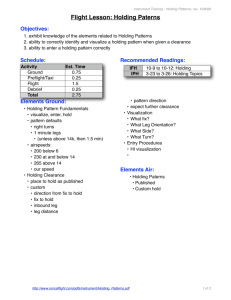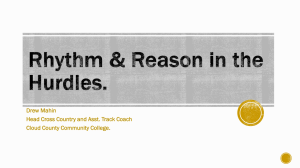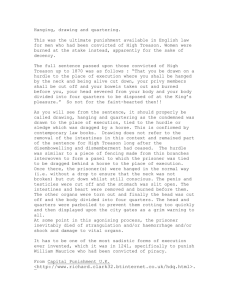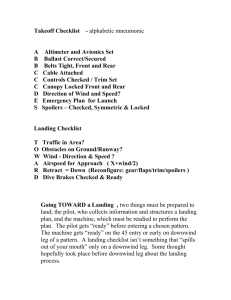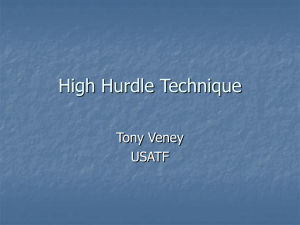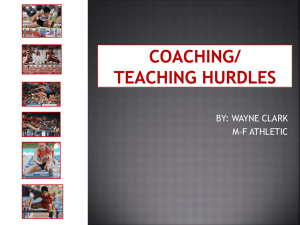Biomechanical Analysis of Hurdling Kale Hintz, Ericka Fischer
advertisement
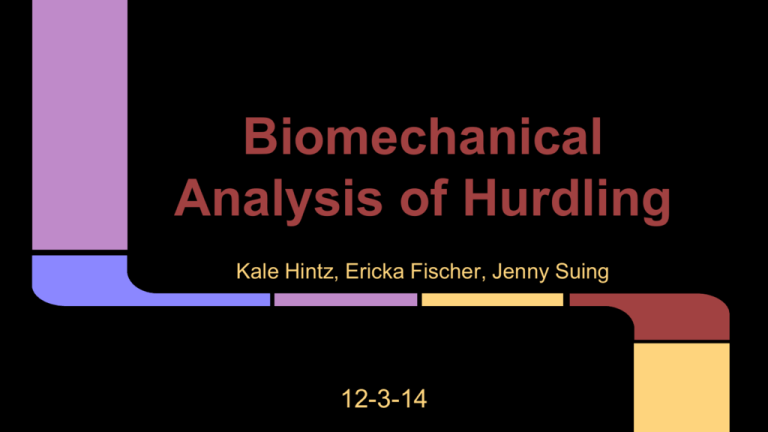
Biomechanical Analysis of Hurdling Kale Hintz, Ericka Fischer, Jenny Suing 12-3-14 Biomechanical Analysis of Hurdling Kale Hintz, Ericka Fischer, Jenny Suing 12-3-14 Skill Objectives ❖ Clear the hurdle with the smallest decrease in horizontal velocity as possible Special Considerations ❖ Height of athlete ➢ stride length ❖ Height of hurdles ❖ Flexibility of athlete ➢ specifically at the hip joint Keys to Successful Hurdling ❖ Spending as much time as possible sprinting ❖ Spending as little time in the air as possible (a perfected clearance technique) (Pierre Beaulieu, 2012) Center of Mass ❖ Raise just above the hurdle to allow for clearance ❖ Lean forward while clearing hurdle to minimize center of mass elevation ➢ Leaning forward allows for more aerodynamic posture (Pierre Beaulieu, 2012) Projectile Motion ❖ Minimize potential energy by reducing elevation ❖ Maximize kinetic energy by spending as much time as possible sprinting ❖ Vertical height directly affects time ❖ By keeping the center of mass low as possible the runner is able to decrease time ❖ By lowering the center of mass less initial velocity is required to clear the hurdle (Pierre Beaulieu, 2012) Momentum Momentum is lost when: ❖ stutter-stepping occurs ❖ the hurdle is hit *Hitting the hurdle is an inelastic collision Anatomy/ Function of Hurdling (Leg) Mono-articulating ❖ ❖ ❖ ❖ ❖ ❖ Short head of Bicep Femoris Vastus muscles *Gluteus Maximus *Tensor Fasciae Latae Adductors Soleus These muscles provide ❖ Stability and leverage ❖ Force & work generators ❖ Lose tension in quick movements Anatomy/ Function of Hurdling (Leg) Bi-articulating ❖ ❖ ❖ ❖ ❖ ❖ ❖ ❖ Psoas Major Hamstrings Bicep Femoris Semimembranosus Semitendinosus Rectus Femoris Gracilis Gastrocnemius These muscles provide ❖ ❖ ❖ ❖ High speed movements Saves energy by allowing concentric work to be done on one end and eccentric on the other Transfers energy while resisting moments across adjacent joints (isometric function) Effects timing of muscle activation on vertical jump Phases Hurdling Phases ❖ Take-off Phase ❖ Flight Phase ➢ ➢ ➢ Splitting Clearance Landing Preparation ❖ Landing Phase Take-off phase ❖ Aggressive run at the hurdle ❖ Stay of ball’s of feet ➢ allows for less braking effect which which would otherwise lead to slower horizontal velocity ❖ Avoid sinking center of mass ❖ Shifting of lead leg, arms, and trunk must be performed simultaneously Take-off phase ❖ Pelvic orientation ❖ Minimizing loss in velocity ❖ Athlete must maintain a high position of center of mass during take-off ❖ Lead knee is driven up and at the hurdle Biomechanical errors ❖ Taking too long of a stride before take-off ❖ Last stride is too close to the hurdle ❖ Lead leg is brought out to the side Flight Phase ❖ Three different phases ➢ ➢ ➢ Splitting phase Clearance phase Landing Preparation *The key to this phase is spending as little time as possible in the air Splitting Phase ❖ Hurdler assumes split position ❖ Opposite arm reaches for opposite leg Clearance Phase ❖ Keep center of mass as low as possible ➢ Leaning forward allows for easier movement of the trail leg ❖ Keeping vertical velocity low allows for less time in the air Biomechanical Errors ❖ Vertical velocity is too high ❖ Trail leg is not brought high enough or is brought under the body Landing Preparation ❖ The main characteristic is the opposed movement behavior of trail and lead leg ❖ Forward trunk lean is kept to continue momentum Biomechanical Errors ❖ Shoulders are not lined up with hips Landing Phase ❖ Landing in plantar flexion of the lead leg allows for minimal loss in horizontal velocity ❖ High knee rotation allows for better clearance of the hurdle References https://www.youtube.com/watch?v=gveS_0sFOmw&list=PLYhTif3-2kJBBTLd4fC7QL3uIiAWsvvzH&index=34 Pierre Beaulieu, H. O. (2012). Blood lactate levels of decathletes during competition. Education Physique of Sports, University of Bordeaux , France, 146-157. McLean, B. (2011). THE BIOMECHANICS OF HURDLING: FORCE PLATE ANALYSIS TO ASSESS HURDLING TECHNIQUE. Australian Institute of Sport, Belconnen, Canberra, Australia, 333-335. Coh, M., & Iskra, J. (2012). Biomechanical Studies of 110 M Hurdle Clearance Technique. Sport Science, Faculty of EducationUniversity of Travnik, Bosnia, & Herzegovina, 10-13. Coh, M. (2003). Biomechanical analysis of Colin Jackson's hurdle clearance technique. New studies in athletics, 18(1), 37-45. Coh, M., Milanovic, D., & Kampmiller, T. (2011). Morphologic and Kinematic Characteristics of Elite Sprinters. Original Scientific Paper, 605-610 Skill Objectives ❖ Clear the hurdle with the smallest decrease in horizontal velocity as possible Special Considerations ❖ Height of athlete ➢ stride length ❖ Height of hurdles ❖ Flexibility of athlete ➢ specifically at the hip joint Keys to Successful Hurdling ❖ Spending as much time as possible sprinting ❖ Spending as little time in the air as possible (a perfected clearance technique) (Pierre Beaulieu, 2012) Center of Mass ❖ Raise just above the hurdle to allow for clearance ❖ Lean forward while clearing hurdle to minimize center of mass elevation ➢ Leaning forward allows for more aerodynamic posture (Pierre Beaulieu, 2012) Projectile Motion ❖ Minimize potential energy by reducing elevation ❖ Maximize kinetic energy by spending as much time as possible sprinting ❖ Vertical height directly affects time ❖ By keeping the center of mass low as possible the runner is able to decrease time ❖ By lowering the center of mass less initial velocity is required to clear the hurdle (Pierre Beaulieu, 2012) Momentum Momentum is lost when: ❖ stutter-stepping occurs ❖ the hurdle is hit *Hitting the hurdle is an inelastic collision Anatomy/ Function of Hurdling (Leg) Mono-articulating ❖ ❖ ❖ ❖ ❖ ❖ Short head of Bicep Femoris Vastus muscles *Gluteus Maximus *Tensor Fasciae Latae Adductors Soleus These muscles provide ❖ Stability and leverage ❖ Force & work generators ❖ Lose tension in quick movements Anatomy/ Function of Hurdling (Leg) Bi-articulating ❖ ❖ ❖ ❖ ❖ ❖ ❖ ❖ Psoas Major Hamstrings Bicep Femoris Semimembranosus Semitendinosus Rectus Femoris Gracilis Gastrocnemius These muscles provide ❖ ❖ ❖ ❖ High speed movements Saves energy by allowing concentric work to be done on one end and eccentric on the other Transfers energy while resisting moments across adjacent joints (isometric function) Effects timing of muscle activation on vertical jump Phases Hurdling Phases ❖ Take-off Phase ❖ Flight Phase ➢ ➢ ➢ Splitting Clearance Landing Preparation ❖ Landing Phase Take-off phase ❖ Aggressive run at the hurdle ❖ Stay of ball’s of feet ➢ allows for less braking effect which which would otherwise lead to slower horizontal velocity ❖ Avoid sinking center of mass ❖ Shifting of lead leg, arms, and trunk must be performed simultaneously Take-off phase ❖ Pelvic orientation ❖ Minimizing loss in velocity ❖ Athlete must maintain a high position of center of mass during take-off ❖ Lead knee is driven up and at the hurdle Biomechanical errors ❖ Taking too long of a stride before take-off ❖ Last stride is too close to the hurdle ❖ Lead leg is brought out to the side Flight Phase ❖ Three different phases ➢ ➢ ➢ Splitting phase Clearance phase Landing Preparation *The key to this phase is spending as little time as possible in the air Splitting Phase ❖ Hurdler assumes split position ❖ Opposite arm reaches for opposite leg Clearance Phase ❖ Keep center of mass as low as possible ➢ Leaning forward allows for easier movement of the trail leg ❖ Keeping vertical velocity low allows for less time in the air Biomechanical Errors ❖ Vertical velocity is too high ❖ Trail leg is not brought high enough or is brought under the body Landing Preparation ❖ The main characteristic is the opposed movement behavior of trail and lead leg ❖ Forward trunk lean is kept to continue momentum Biomechanical Errors ❖ Shoulders are not lined up with hips Landing Phase ❖ Landing in plantar flexion of the lead leg allows for minimal loss in horizontal velocity ❖ High knee rotation allows for better clearance of the hurdle References https://www.youtube.com/watch?v=gveS_0sFOmw&list=PLYhTif3-2kJBBTLd4fC7QL3uIiAWsvvzH&index=34 Pierre Beaulieu, H. O. (2012). Blood lactate levels of decathletes during competition. Education Physique of Sports, University of Bordeaux , France, 146-157. McLean, B. (2011). THE BIOMECHANICS OF HURDLING: FORCE PLATE ANALYSIS TO ASSESS HURDLING TECHNIQUE. Australian Institute of Sport, Belconnen, Canberra, Australia, 333-335. Coh, M., & Iskra, J. (2012). Biomechanical Studies of 110 M Hurdle Clearance Technique. Sport Science, Faculty of EducationUniversity of Travnik, Bosnia, & Herzegovina, 10-13. Coh, M. (2003). Biomechanical analysis of Colin Jackson's hurdle clearance technique. New studies in athletics, 18(1), 37-45. Coh, M., Milanovic, D., & Kampmiller, T. (2011). Morphologic and Kinematic Characteristics of Elite Sprinters. Original Scientific Paper, 605-610
